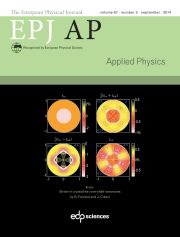Article contents
Use of Rutherford Backscattering Spectrometry for studyingthe passivation of materials of rechargeable batteries: application to petroleum coke in LiCF3SO3/carbonates mixture electrolyte
Published online by Cambridge University Press: 15 January 2000
Abstract
The evolution of the passivating layer (during the firstreduction/reoxidation cycle, in function of the number of reduction/reoxidationcycles and with the storage of the electrode in the electrolyte) formed at thesurface of a lithiated carbon electrode in LiCF3SO3/carbonates mixture electrolytehas been followed by using 1 MeV 4He+ induced Rutherford BackscatteringSpectrometry (RBS). Two RBS simulation codes "RUMP" and "PERM" , whose approachesare different, have been applied to the treatment of the RBS data and have allowedto obtain informations about the structure (thickness and atomic elementalcomposition) of the passivating layer. These two codes provide similar results. Thepassivating layer has a thickness in the range 20-30 nm. Its structure appears tobe complex with the presence of two different sublayers respectively composed of thereduction products of the salt in the inner sublayer (with the main presence offluorine and sulphur indicating the possible existence of LiF and Li2S) andreduction products of the solvents in the outer sublayer (with a high concentration in oxygen indicating the presence of Li2CO3 and RCO3Li where R is an alkylradical).
Information
- Type
- Research Article
- Information
- Copyright
- © EDP Sciences, 2000
References
- 1
- Cited by

